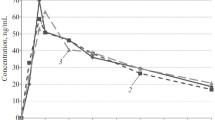Summary
Blood pressure, ECG and plasma concentration were determined for up to 12h following single i.v. (10 mg) and oral (20 mg) doses of amezinium (Regulton®) in 8 healthy, male volunteers. The i.v. and oral doses were almost equi-active in significantly increasing systolic blood pressure (SBP) by 14.5 and 15.6 mmHg, respectively. The maximum SBP after the i.v. dose was reached after 45 min, and 105 min after oral administration. The heart rate fell reflexly. The increases in mean and diastolic blood pressures were not significant. Pulse pressure was enhanced after both i.v. and oral administration. The effect on systolic blood pressure lasted for about 4 h. There was a slight shortening of the QTc duration, which could not be explained as a drug effect. Other ECG time intervals were not altered. Multiple regression analysis showed a significant positive correlation between the log plasma concentration and the increase in SBP between 0.5 and 5 h after oral administration (r=0.78,p<0.001) and between 0.75 and 5 h after i.v. administration (r=0.83,p<0.001). 30 min after amezinium p.o. the mean SBP began to rise, when a plasma level of about 30 ng/ml was reached.
Similar content being viewed by others
References
Bazett HC (1920) An analysis of the time relation of the electrocardiogram. Heart 7: 353–370
Bibermann L, Sarma RN, Surawicz B (1971) T-wave abnormalities during hyperventilation and isoproterenol infusion. Am Heart J 81: 166–174
Boudoulas H, Geleris P, Lewis RP, Leier CV (1981) Effect of increased adrenergic activity on the relationship between electrical and mechanical systole. Circulation 64: 28–33
Burnstock G (1975) Innervation of vascular smooth muscle: histochemistry and electron microscopy. Clin Exp Pharmacol Physiol 2[Suppl]: 7–20
Eckberg DL (1980) Nonlinearities of the human carotid baroreceptor-cardiac reflex. Circ Res 47: 208–216
Fitzgerald GA, Hossmann V, Hamilton CA, Reid JL, Davies DS, Dollery CT (1979) Interindividual variation in kinetics of infused epinephrine. Clin Pharmacol Ther 26: 669–675
Kaumeier S, Kehrhan OH, Morgenthaler H, Neugebauer G (1981) Absolute bioavailability of amezinium. A cross-over study after i.v. and p.o. application. Arzneim Forsch (Drug Res) 31 (II): 1653–1657
Lehmann HD, Giertz H, Kretzschmar R, Lenke D, v. Philipsborn G, Raschack M, Schuster J (1981) Pharmacology of amezinium, a novel antihypotensive drug. II Examination of cardiovascular effects. Arzneim Forsch (Drug Res) 31 (II): 1544–1557
Lenke D, Gries J, Kretzschmar R (1981) Pharmacology of amezinium, a novel antihypotensive drug. III Studies on the mechanism of action. Arzneim Forsch (Drug Res) 31 (II): 1558–1565
Oloff SH (1981) A synopsis of the therapeutic trials of amezinium. Arzneim Forsch (Drug Res) 31 (II): 1656–1671
Remington JW, Ahlquist RP (1953) Effect of sympathomimetic drugs on the QT interval and on the duration of ejection. Am J Physiol 174: 165–170
Reuter H (1974) Exchange of calcium ions in the mammalian myocardium. Mechanisms and physiological significance. Circ Res 34: 599–605
Steppeler A, Pfändler R, Hedler L, Starke K (1980) An analysis of the effects of amezinium on postganglionic sympathetic neurones. Arch Pharmacol 314: 1–11
Steppeler A, Starke K (1980) Selective inhibition by amezinium of intraneuronal monoamine oxidase. Arch Pharmacol 314: 13–16
Traut M, Brode E, Hoffmann D (1981a) Pharmacology of amezinium, a novel antihypotensive drug. IV Biochemical investigation of the mechanism of action. Arzneim Forsch (Drug Res) 31 (II): 1566–1574
Traut M, Brode E, Wilsmann K (1981b) Pharmakokinetik und Pharmakodynamik von Ameziniummetilsulfat beim Menschen. Z Kardiol 70: 292
Traut M, Morgenthaler H, Brode E (1981c) Determination of amezinium in body fluids. Arzneim Forsch (Drug Res) 31 (II): 1589–1593
Traut M, Brode E (1981) Pharmacokinetics of amezinium in man. Arzneim Forsch (Drug Res) 31 (II): 1605–1615
Trautwein W, Kassebaum DG, Nelson RM, Hecht HH (1962) Electrophysiological study of human heart muscle. Circ Res 10: 306–312
Wilsmann K, Neugebauer G, Kessel R, Lang E (1981a) Haemodynamic effects of amezinium in man. Arzneim Forsch (Drug Res) 31 (II): 1638–1646
Wilsmann K, Neugebauer G, Kessel R, Lang E (1981b) Cardiovascular effects of amezinium in humans during passive upright tilt in comparison with norfenefrine and dihydroergotamine. Arzneim Forsch (Drug Res) 31 (II): 1647–1652
Author information
Authors and Affiliations
Rights and permissions
About this article
Cite this article
Neugebauer, G., Kaumeier, H.S., Kehrhahn, O.H. et al. Pharmacodynamic and pharmacokinetic evaluation in man of the new sympathomimetic amezinium. Eur J Clin Pharmacol 24, 185–190 (1983). https://doi.org/10.1007/BF00613815
Received:
Revised:
Accepted:
Issue Date:
DOI: https://doi.org/10.1007/BF00613815




